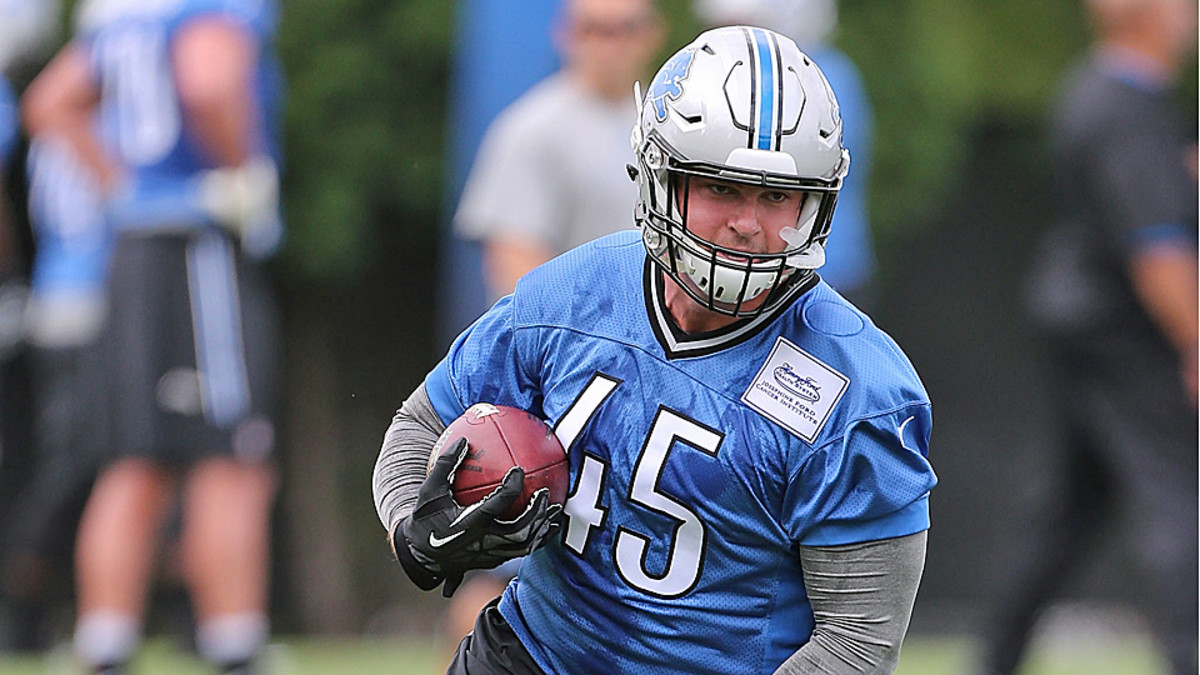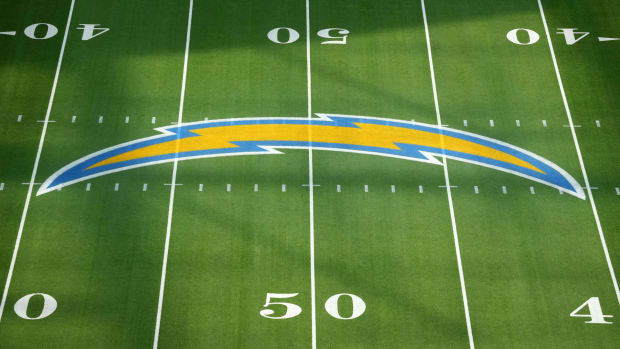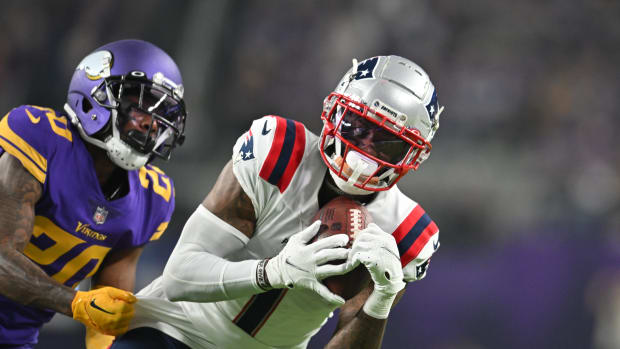
NFL fullbacks doing 'anything and everything' to remain relevant
ALLEN PARK, Mich. -- Perhaps Mother Nature is a sportswriter.
The Lions' first-team offense is on the field for an 11-on-11 drill late in a Monday morning practice. Reggie Bush takes his place at running back, Calvin Johnson wide left, Golden Tate wide right, Brandon Pettigrew at tight end -- the whole setup a fantasy footballer's dream come to life.
As quarterback Matthew Stafford moves under center, the sun, now threatening to push the mercury from pleasant to warm, catches him. Standing in Stafford's shadow, quite literally, is fullback Jed Collins.
Arrival of Revis, Browner signals new approach for Patriots secondary
The imagery is perfect. Collins is an anonymous piece to a star-laden puzzle here, same as he previously was in New Orleans on a depth chart dotted by Drew Brees, Jimmy Graham and others. Certainly, the couple hundred diehard fans playing hooky to take in this particular practice are not watching Collins, but rather waiting on a Megatron catch or a Bush breakaway.
Then, the snap. Collins cuts to his left and fills a hole between center and guard, lowering his shoulder as he plows forward to square up linebacker DeAndre Levy. Bush follows behind him, the ball in tow after a hand-off from Stafford, and bursts through the opening created by the block by Collins.
The scene repeats itself in various fashion, Collins sharing snaps with Montell Owens and Chad Abram, two other rather nondescript teammates. Collins receives no carries. No passes are thrown his direction.
RANKINGS: QBs | WRs | TEs | Safeties | CBs | DTs | Pass rushers | LBs | OL
After practice ends, Collins is stopped for an interview. He begins to walk away when it's over, then turns and calls out to the reporter:
"Hey, thanks. I appreciate you giving the fullbacks some love."
The longest passing play in Washington Huskies history occurred in 2007, when Marcel Reece hauled in a bomb from Jake Locker and raced to the end zone for a 98-yard score. Reece finished that season, his second of two at UW after transferring in from El Camino CC, with eight touchdown receptions and a 19.5 yards-per-catch average. He ran a 4.42 40 and posted a vertical of more than 36 inches at Washington's pro day.
But when the '08 draft rolled around ... nothing.
NFL teams did not know what to make of the 6-foot-2, 220-pounder, despite his fleeting success as a college wide receiver. It was only when Reece eventually landed with the Raiders, after a failed stop in Miami, that a plan began to form.
"I feel like it was [former Raiders owner] Al Davis that was ahead of everyone," Reece told SI via phone from training camp. "A lot of people say I revolutionized the H-back [position], but it was really all Al Davis. The transformation never crossed my mind until I came here, and he told me, 'You're going to be the best fullback in the game. You're going to change the game.'
"That's what Mr. Davis told me. Honestly, it was him that was ahead of the game, I was just the character that played the part."
Reece spent close to two full seasons on the Raiders' practice squad before making his NFL debut as a fullback late in 2009. By 2010, he was a full-time starter; by 2012, a Pro Bowler. Yet, even now, his role remains something of an unsettled enigma. He has proven to be more than solely a blocking back, but how much should he have the ball? Following a 24-7 loss to the Chiefs last season in which Reece finished with one catch and no rushing attempts, Oakland head coach Dennis Allen emphasized the need to get Reece far more involved moving forward. Reece wound up with just nine total touches over the next three games.
With new plan for RGIII, Redskins' passing game still a work in progress
The challenge of creating offensive opportunities for him has remained, as with most athletic fullbacks around the league. Reece does not fit the mold as a pure running back nor as a tight end and he has long left his receiver days behind.
"I never really try to limit or pigeon hole myself. I just say playmaker, any shape or form," Reece said. "Blocking in pass protection, blocking in the run game, also just running the ball or catching the ball. One thing that stuck with me when I first made the transformation from wide receiver to fullback was [then-Raiders head coach] Tom Cable told me a fullback is basically a pseudo guard -- a more athletic, more agile guard. You have to be able to do anything and everything on the field."
The prominence of the H-back position has blurred the line between fullback and tight end more now than arguably ever before. Just two players designated as fullbacks were selected in the 2014 draft, Jay Prosch by Houston and Trey Millard by San Francisco. The latter lined up at several positions for Oklahoma, while Texans head coach Bill O'Brien clearly had a Reece-like role in mind for Prosch when that selection was made.
"When you project ahead to a gameday roster, where you have 46 guys -- that's not a lot of guys -- so I think the more you can do as a player, that's good for the football team," O'Brien said. "We always look for guys who can do more."
2014 Fantasy Football Sleepers
Knile Davis - RB, Kansas City Chiefs
Terrance West - RB, Cleveland Browns
Dri Archer - RB, Pittsburgh Steelers
Lache Seastrunk - RB, Washington Redskins
Ka’Deem Carey - RB, Chicago Bears
Devonta Freeman - RB, Atlanta Falcons
Christine Michael - RB, Seattle Seahawks
Carlos Hyde - RB, San Francisco 49ers
Tre Mason - RB, St. Louis Rams
Chris Polk - RB, Philadelphia Eagles
Charles Sims - RB, Tampa Bay Buccaneers
Markus Wheaton - WR, Pittsburgh Steelers
Marqise Lee - WR, Jacksonville Jaguars
Kenny Stills - WR, New Orleans Saints
Kelvin Benjamin - WR, Carolina Panthers
Tavon Austin - WR, St. Louis Rams
Justin Hunter - WR, Tennessee Titans
Jordan Matthews - WR, Philadelphia Eagles
Eric Ebron - TE, Detroit Lions
Ladarius Green - TE, San Diego Chargers
No teams threw more passes in 2011 or '12 than the Detroit Lions and New Orleans Saints, who finished ranked No. 1 and No. 2, respectively, in that category both years. The two high-powered offenses landed among the top-five again in 2013 and are primed to air it out again this season.
So how is it that Collins, a 255-pound grinder with fewer than 40 career receptions, became a connection between the two?
"The fullback has to understand his role in the game today," said Collins, sporting the No. 45 jersey worn for three years in Detroit by Jerome Felton, now the lead blocker for Minnesota superstar Adrian Peterson. "This is a pass-happy league, guys get paid a lot of money to put the ball in the air and make big plays and get touchdowns. We [fullbacks] take pride in the short-yardage stuff, we take pride in closing out games.
"As I entered the league, the fullback was a dying breed. I think we're on our upswing again. People appreciate how important ball security and ball control is, time management. ... I think you look at the playoffs and I would say the majority of teams have a good run game, solid fullback. Super Bowl teams of the last few years have had fullbacks. Teams see that."
Fixing the QBs: Will Andy Dalton ever learn to thrive under pressure?
Collins, who was a member of five practice squads before landing with the Saints, is no lock to make the Lions' roster (Owens was listed as the first-team fullback for Detroit's preseason opener). Should he fail to claim a spot, an uncertain future would await. Currently, Vonta Leach and Le'Ron McClain -- two fullbacks with 17 seasons and four All-Pro bids between them -- linger as free agents.
The H-back renaissance may have helped versatile players like Reece. It has done no favors for Collins and others who make their livings almost exclusively by paving the way for more talented teammates.
"You can use a tight end to do some of the same things [as a fullback] if he has that skill set," said Lions offensive coordinator Joe Lombardi, part of a new staff that was nonetheless adamant about bringing in a fullback this offseason. "Jed, knowing what he can do, it's [helpful with] two things: the run game and play-action passing. Those run plays, those formations do set up a lot of big plays for you."
Collins ran the ball 15 times and caught 14 passes last season, totaling a measly 99 yards. Unlike Reece, Collins will not be asked by Detroit (at least not very often) to motion out of the backfield or sneak up the seam. "He's not going to run corner routes," Lombardi said, smiling. "He'll be the first to tell you he'd be great at it but ... "
A throwback talent with a limited skill set, Collins is well-aware of what the Lions expect from him.
"There are two types of football players: artists and tough guys. I'm a tough guy," he said. "I make room for the artists to do what they do."
What might the future hold for the fullback position?
Is it enough to be just a blocker or short-yardage weapon, as Collins more or less is? Or as the game continues to evolve, as offenses tinker with their creativity, will it take players like Reece to fill that role -- a hybrid option, an H-back?
"You need a fullback," the Giants' Henry Hynoski said at camp, via NJ.com. "If you want to be physical and run the football, you need a fullback. If you want to be committed to the ground game, you need a fullback."
Players like Collins or, say, the Chiefs' Anthony Sherman, who was on the field for 391 snaps last season with two rushing attempts, hope Hynoski's words prove true.
Ironically, the same fundamental change that has led to an influx of H-back types to the NFL could be helping to keep power fullbacks around. Defenses are lighter and faster these days, in an effort to combat spread offenses and mobile quarterbacks. So players like Collins, Felton or Sherman -- those that make their livings pounding between the tackles -- may be developing an edge simply by staying physical.
"In this game, there are tidal waves of shifts in terms of what's being installed," said Collins. "The last four or five years, it's been a pass-happy league, everyone wants the ball in the air and defenses have shifted. That's why the fullback has come back in, to exploit what the defenses have given."
Of course, how much can be exploited depends on which player we're talking about. Reece is not the same player as Collins; Collins is not a carbon copy of Prosch or San Francisco's Bruce Miller or Green Bay's John Kuhn. This is nothing new for the position, however. Jim Brown played fullback, but so too did Marion Motley, Larry Csonka and Mike Alstott, all different types of players in their own right.
What defines a fullback has become as much about mentality as responsibility.
Seconds before the credits roll on Batman Begins, Commissioner Gordon says to the masked hero, "I never said thank you."
Bruce Wayne responds, in his throaty Christian Bale-ness: "And you'll never have to."
This is how, for the most part, the modern NFL fullback goes about his business: quietly, without much fanfare, borderline unappreciated.
Rookie James White prepared to shake up Patriots' RB depth chart
Following an injury to Miller last season, San Francisco head coach Jim Harbaugh talked about how valuable his fullback is in all facets of the game -- blocking, running, pass-catching. The Raiders sing a similar song about Reece. First and foremost, though, any player assigned to the fullback role is expected to set the table for his teammates.
"If called upon, I can catch the ball or run the ball, but I'm pretty sure we'd rather have Calvin or Golden or Reggie doing those things," Collins said. "You understand your role. My job here is to instill that mentality of closing out games, that thinking if you need one yard, you get that one yard."
The fullback glory days may be in the past. The sun hardly has set on the position as a whole.
"Some people don't even consider me a fullback," he said, "but for me, when someone asks me my position, I'm a fullback. That's what I provide for my team. ... There's always going to be room on any team for a fullback who can block a guy, lead block on any given down."
























































